
Posts Tagged: Small Farm Program
Discover California Farms... ...at California Fairs!
A guide for specialty crop promotion and education at California district and county fairs
Almost everyone in California enjoys our county and district fairs, but most people attending California fairs don't know much about local farmers or the crops that are grown in their own region. Many fairs and members of California agricultural communities are trying new ways to connect local farmers with fair attendees.
Specialty crops – fruits, vegetables, nuts, herbs, flowers, honey, and the products created from them – are a big deal in California. California farmers feed their local communities, provide about half of the fruits and vegetables eaten in the United States, and export their crops and products around the world. Fairs attract thousands of visitors from urban, suburban and even rural communities who have never met a farmer or visited a farm and often do not know what is growing in fields and orchards surrounding their communities. California fairs offer opportunities for the agricultural community to connect with these visitors.
In 2013 and 2014, the California Department of Food and Agriculture's Division of Fairs and Expositions collaborated with the University of California Small Farm Program to organize 20' by 40' interactive, fun and educational exhibits at four different California District Fairs to teach about local farms, crops and farmers' markets and promote fresh fruits, vegetables, nuts, herbs, flowers and honey to fair-goers.
Project staff created a guide to specialty crop education and promotion at county fairs, based on the experience of the many farmers, educators, fair officials and community groups participating in that project. The guide is funded by a California Department of Food and Agriculture Specialty Crop Block Grant, as part of the "Mobile Agriculture Education Exhibit" Project.
The 22 page guide is available here as a downloadable pdf file:
Discover California Farms... ...at California Fairs!
Agritourism Intensive classes help grow supportive networks and new enterprises

“We really enjoy having people on our farm. We have started hosting tours, for fees, including 2 bus tours with more than 40 people. We also remodeled our 100 year old farm house, added a bathroom upstairs to make it ready for a farm stay. Our kids are very involved in these activities. Agritourism is definitely part of our farm plan now.”
Rancher Kathy Landini participated in a similar agritourism planning class in Orland two years ago, and reached different conclusions with her family about agritourism on their ranch:
“Although we are thinking of offering ranch stays, after a family conference we held off. We decided that family privacy and family time would be diminished if we had guests. The kids did not feel that they would be as comfortable coming home.”
Classes offered throughout California
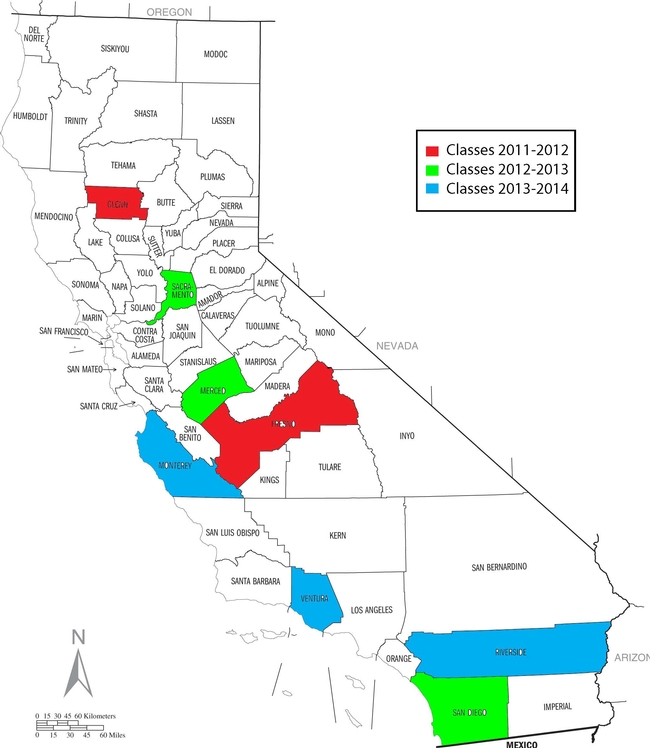
Our goals – new skills and new networks
Because agritourism involves providing a memorable experience to visitors instead of (or in addition to) an agricultural product, agritourism operators must develop new and different relationships with their customers. Attracting and caring for guests usually also requires farmers and ranchers to learn new skills and to form new partnerships with each other and with risk management, hospitality and marketing professionals. Our goals for the classes were to increase understanding of the agritourism industry by participants, and to provide them with skills, resources and connections to plan, start and market their own agritourism businesses or to decide that agritourism was not right for their farm, ranch or family at this time.
Our process – interaction & local connections
The Agritourism Intensive classes used hands-on, interactive activities to guide participants in assessing their own farms or ranches for agritourism potential and starting their own business, risk management, and marketing plans. 
Long term follow-up
After offering the classes for three years, we wanted to learn if we were meeting our goals. To learn whether the classes were useful to participants, we contacted the people who took the class two years ago in Fresno and Orland, and the people who completed the class in Sacramento a year ago. We asked if they had started or expanded agritourism activities since their class ended. We also asked whether they had stayed in touch with fellow class participants or presenters.
We heard back from 29 families, or 40 percent of those contacted. Of these, 22 were farmers or ranchers. (The others were tourism professionals, insurance agents, or other related people who work with agritourism operators). We learned that more than half of the responding farmers or ranchers had started or expanded agritourism activities since the class. We heard from a few who had used the class to decide not to pursue agritourism at this time. More than 80 percent of the people responding told us that they had worked with, collaborated with or consulted with at least one person who participated or presented in their class, since the class ended.
Here are some more excerpts from the responses to our inquiry:
Network is continuing
- I have pretty steady contact with some of the people from the class. People call a lot and ask questions about our trail-riding operation.
- The presenter from the Convention & Visitors Bureau has been a great resource to us, bringing some tour group leaders to us and referring other tour groups.
- I visited one of the class presenters and fellow participants to see and learn about his fishing pond operation.
- I purchased 2 mares for my summer camp from someone I met in the class
Many still moving forward…
- We are developing our lavender field and shop in preparation for opening to the public later this spring
- We got our roadside stand up. It's doing OK so far. We were investigating this possibility when we took the class
- Our blueberry U-Pick is still going. We were in the process of opening when I took the class. We have been open for a few years and would like to expand.
Some decided against agritourism…
- Concerns about liability squelched our initial plans to hold weddings on the site.
- Biosecurity has changed our plans for agritourism since we raise chickens.
Conclusion
Although our long term follow-up response was only a small sample, we were pleased to learn that the classes seemed helpful in growing agritourism enterprises and supportive networks. We learned that agritourism businesses can take time, sometimes several years, to grow, especially when farmers are busy farming. We also can say that local networks are important and durable resources for agritourism development.
View a presentation about the Agritourism Intensive classes and follow-up conversations given by UC Small Farm Program Agritourism Coordinator Penny Leff at the Women in Agriculture Educators National Conference, April 2014
California drought and the fate of the state’s beloved berries

To find out, farm advisors around the state are comparing strawberries, blueberries and blackberries grown under four irrigation regimes – one that reflects the normal practice, one half the normal amount of water, one 75 percent of normal, and one that is 25 percent more than normal. The studies are being conducted in Santa Clara, San Luis Obispo, San Diego and Fresno counties.
“We’re doing this because of the water issue in California,” said Richard Molinar, UC Cooperative Extension advisor in Fresno County. “We’re in drought mode. We want to look at ways farmers can cut back the amount of water they are using and still have good tasting berries.”
Molinar recently brought samples of strawberries grown at the UC Kearney Agricultural Research and Extension Center in Parlier to the Vineyard Farmers Market in Fresno and invited patrons to share their preferences. Strawberry tasters were asked to evaluate the fruits’ appearance, flavor and texture. The advisors will aggregate information from taste testing done on berries from all the research sites.
The research will go beyond consumers’ preferences. Beth Mitcham, UCCE specialist in the Department of Plant Sciences at UC Davis, will evaluate the fruit grown under different irrigation regimes in the laboratory. Mitcham’s research will determine the amount of sugar, the sugar-acid ratio and the amount of antioxidants in the fruit and how these are affected by increasing or decreasing the usual amount of irrigation water.
The study is funded with a specialty crops grant from the California Department of Food and Agriculture awarded to the small farm program under the direction of Shermain Hardesty, UC Cooperative Extension specialist in the Department of Agricultural and Resource Economics at UC Davis.
See video of the strawberry tasting here:
Investing in food values: Slow Money founder to speak in Davis

The talk, along with introductions, Q&A and light refreshments, will be 4 – 6 p.m. at the Rominger West Winery, 4602 Second St. in Davis. Tickets are $10, and reservations are available online at http://ucanr.org/slowmoney.
Slow Money is a national network dedicated to investing in local food and agricultural enterprises.
“We often hear about ‘voting with your dollar’ when it comes to supporting small-scale farmers and local food,” said Shermain Hardesty, Cooperative Extension economist in the UC Davis Department of Agricultural and Resources Economics. “Shopping at a farmers market or becoming a CSA member are ways to support small-scale farms as a consumer, but Slow Money can be a way to invest in them.”
One local venture which has sought funding through Slow Money is the Capay Valley Farm Shop, a collaborative of 30 farms and ranches who together offer a CSA to institutions and corporations.
“Through Slow Money, we’re reaching investors who share our values, who believe that community food systems are a great investment for the health of communities and for the planet,” said Thomas Nelson, president of Capay Valley Farm Shop.
After presenting at an entrepreneur showcase this summer, the Capay Valley Farm Shop is working with a group of interested investors through Slow Money.
Another agricultural venture, Soul Food Farm in Vacaville, has also worked with Slow Money investors, receiving approximately $40,000 in loans.
“This model is another way that entrepreneurs in sustainable agriculture and community food systems can seek funding—especially when conventional sources such as venture capital, the Farm Credit System or commercial banks may not be an option,” Hardesty said.
The event will include a brief introduction to current UC Davis research on values-based food systems by Hardesty and Gail Feenstra, of the Agricultural Sustainability Institute. Values-based food systems create relationships between growers, funders, distributors, consumers and others based on shared values. Their project is working to identify bottlenecks—including access to capital—in the development of these values-based food supply chains, with an eye toward the enhancing the prosperity of smaller producers through networks that support environmental and social sustainability. This research is part of a USDA-funded, multi-state project, along with researchers at Colorado State University and Portland State University.
The event is sponsored by the Davis Food Co-op, Sacramento Natural Foods Co-op and the Giannini Foundation.
More details and ticket reservations for this event are available at http://ucanr.org/slowmoney.
You should taste it fresh
Question: What exotic fruit has been named as a flavor in Starburst candy, Ice Breakers gum, SoBe beverages, Vitamin Water drinks, Bacardi rum and even Axe body spray?
Answer: Dragon fruit. (Hylocereus spp.)
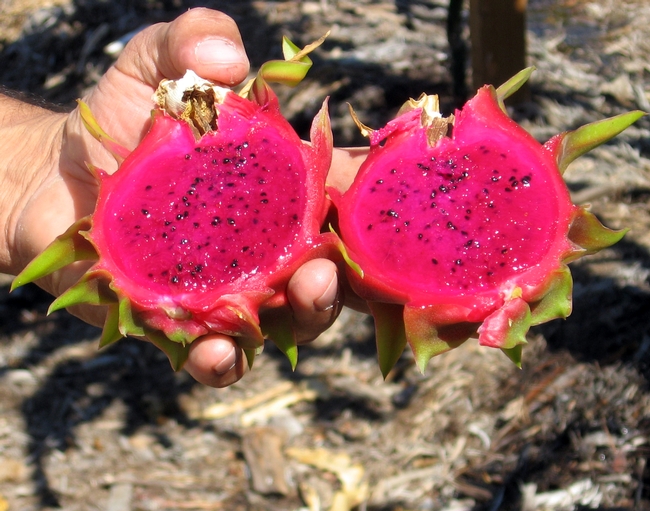
If you want to try one, you may be in luck because now is the peak harvest season in Southern California for this subtropical cactus fruit with the fire-breathing name — also known as pitahaya. And it just so happens that growing and eating fresh dragon fruit is what Ramiro Lobo, UC Cooperative Extension farm advisor for San Diego County and the Small Farm Program, is most interested in.
Lobo says he’s known about pitahaya since he was a kid, but his professional interest was rekindled when the enthusiasm of the Rare Fruit Growers group intersected with an ongoing quest to find crops that are more water-efficient for the region.
“Wherever you can grow Hass avocados, you can grow dragon fruit,” he said. “And it uses less water than avocados or any other orchard crop that we grow in San Diego.”
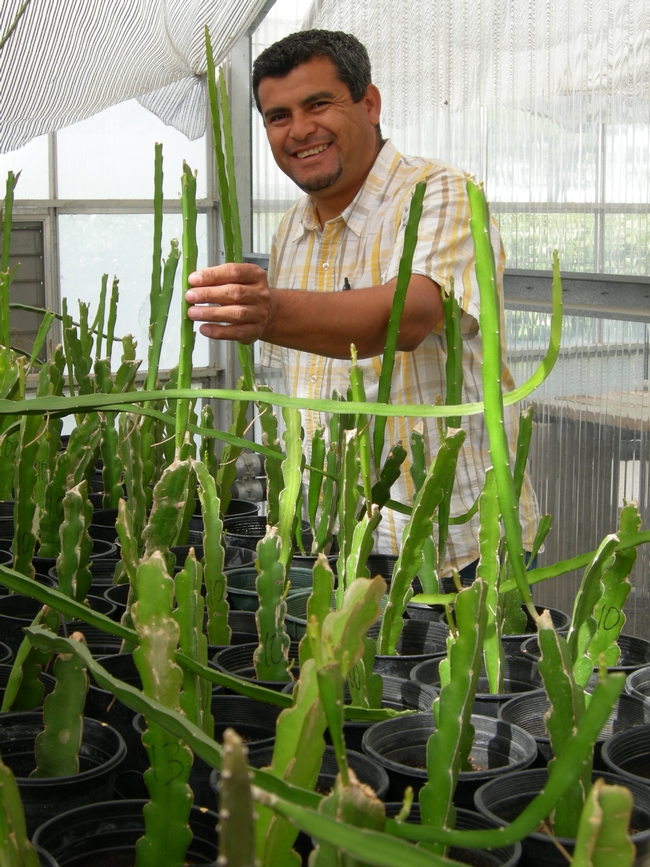
“We’ve seen the market expanding. We’re seeing it in high-end restaurants in Los Angeles and Las Vegas,” he said. “Supply is very sketchy right now, but growers who are selling direct at farmers markets are getting $7-8 per pound. Hardly any other fruit today is bringing that kind of money.”
One other clue that the U.S. market for this “artichoke from Mars” (as one LA Times writer described it) is expanding? Imports of the fruit have been growing from Vietnam, with perhaps 600 tons imported in 2010. And the USDA is currently working through the processes that could allow imports from Mexico, Thailand and Central America too.
While Lobo doesn’t sound too worried about competing with imported dragon fruit, he does hope your first taste of fresh dragon fruit is indeed very fresh.
“We cannot compete with Vietnam fruit for price, but we can definitely compete for quality,” he said. “The challenge is that a lot of people are exposed to dragon fruit, but the fruit quality is lousy. It’s a very sensitive fruit, so if you put it in a container and send it across the ocean for 10 days, it’s not going to be as good. But people who get exposed to a good variety keep buying it.”
In California, it is estimated that about 200 acres are planted in pitahaya, with anywhere from 400 to 1,000 acres planted nationwide.
Lobo oversees approximately 500 dragon fruit plants at the UC South Coast Research and Extension Center in Irvine. He is currently working to set up an irrigation trial for pitahaya, to better evaluate its water requirements. He is also working to test out different trellis systems, comparing hedge versus orchard systems for this fruiting cactus.
The UC South Coast Research and Extension Center is also where the pitahaya field day was held recently. Lobo said questions from the day’s 100 or so participants sounded like more growers are getting serious about growing pitahaya commercially, with more technical questions and an interest in disease, rodent and pest management.
“The bar has been raised, and [some of those questions] even put us in a bind because without the research, it is kind of hard to answer them,” he said.
In the meantime, Californians and marketing companies will probably continue to find new secondary uses for this fruit’s juice, pulp and name: Lobo says he’s seen wines made with dragon fruit and organic yarn dyed naturally with that fiery pink flesh.
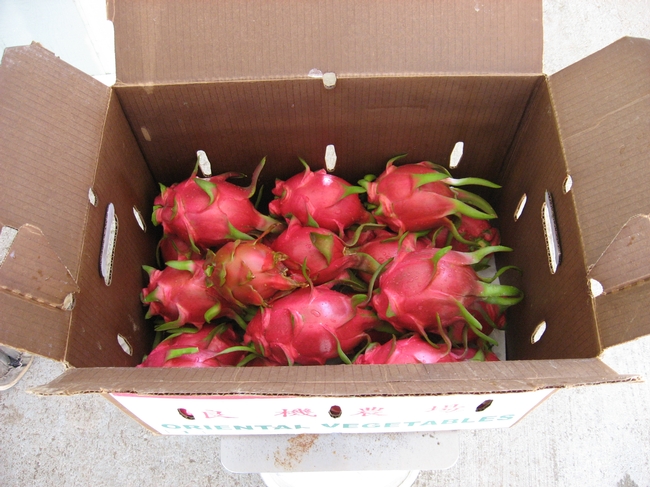
Pitahayas, as packed at a small farm in San Diego. (Photo by Shermain Hardesty)
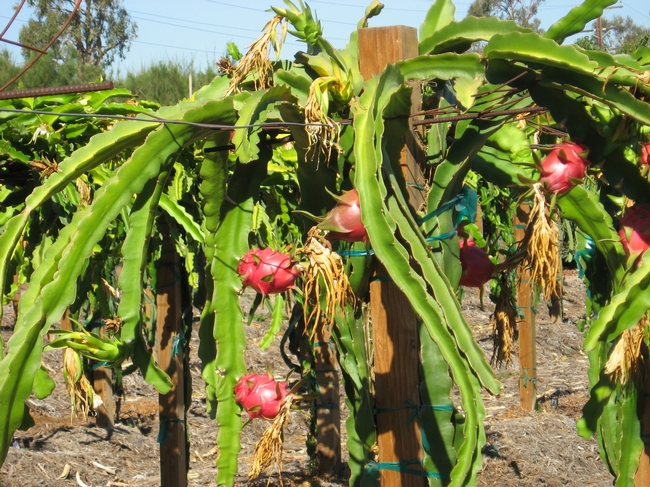
At UC South Coast Research and Extension Center, the dragon fruit plants are currently in an orchard system, though new trellis trials will soon be under way. (Photo by Shermain Hardesty)
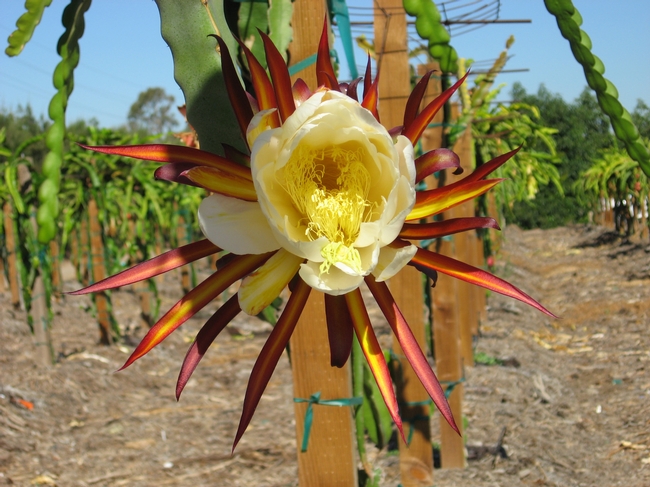
Pitahaya blooms at UC South Coast Research and Extension Center. (Photo by Shermain Hardesty)
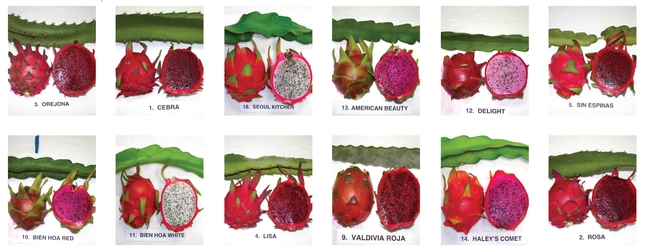
Colors of ripe pitahaya flesh can vary between red, fuschia, pink and white.
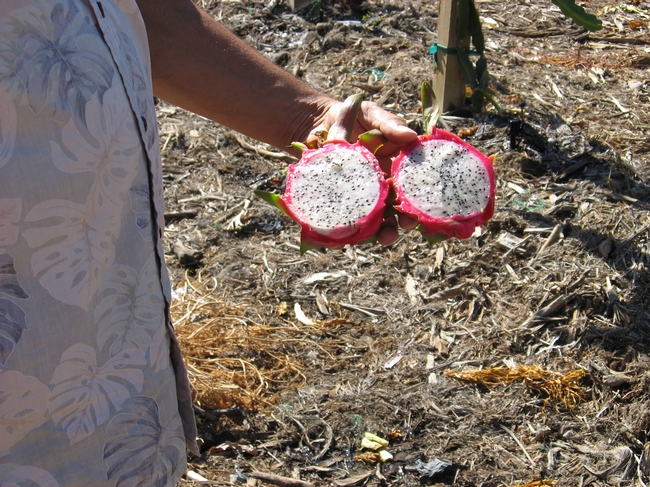
Irvine Field Station white flesh pitahaya


